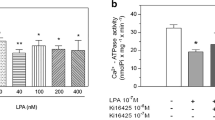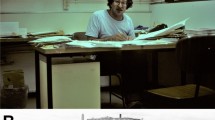Abstract
We have previously reported that rat parotid gland basolateral plasma membrane vesicles (BLMV) have a relatively high affinity Ca2+ transport pathway and an unsaturable Ca2+ flux component (Lockwich et al., 1994. J. Membrane Biol. 141:289–296). In this study, we have solubilized BLMV with octylglucoside (1.5%) and have reconstituted the solubilized proteins into proteoliposomes (PrL) composed of E. coli bulk phospholipids, by using a detergent dilution method. PrL exhibited 3–5-fold higher 45Ca2+ influx than control liposomes (without protein). Ca2+ uptake into PrL was dependent on the [protein] in PrL and steady state [Ca2+] in PrL was in equilibrium with external [Ca2+]. These data demonstrate that a passive, protein-mediated Ca2+ transport has been reconstituted from BLMV into PrL. 45Ca2+ influx into liposomes did not saturate with increasing [Ca2+] in the assay medium. In contrast, PrL displayed saturable 45Ca2+ influx and exhibited a single Ca2+ flux component with an apparent K ca=242 ± 50.9 μm and V max=13.5 ± 1.14 nmoles Ca2+/mg protein/ minute. The K ca of Ca2+-transport in PrL was similar to that of the high affinity Ca2+ influx component in BLMV while the V max was about 4-fold higher. The unsaturable Ca2+ flux component was not detected in PrL. 45Ca2+ influx in PrL was inhibited by divalent cations in the order of efficacy, Zn2+>Mn2+>Co2+=Ni2+, and appeared to be more sensitive to lower concentrations of Zn2+ than in BLMV. Consistent with our observations with BLMV, the carboxyl group reagent N,N′-dicyclohexylcarbodiimide (DCCD) inhibited the reconstituted Ca2+ transport in PrL. Importantly, in both BLMV and PrL, DCCD induced a 40–50% decrease in V max of Ca2+ transport without an alteration in K ca. These data strongly suggest that the high affinity, passive Ca2+ transport pathway present in BLMV has been functionally reconstituted into PrL. We suggest that this approach provides a useful experimental system towards isolation of the protein(s) involved in mediating Ca2+ influx in the rat parotid gland basolateral plasma membrane.
Similar content being viewed by others
References
Ambudkar, I.S., Baum, B.J. 1988a ATP-dependent calcium transport in rat parotid basolateral membrane vesicles is modulated by membrane potential. J. Membrane Biol. 102:59–69
Ambudkar, I.S., Baum, B.J. 1988b. ATP-dependent Ca2+ transport in rat parotid basolateral membrane vesicles is modulated by K+ + Cl− flux. Biochim. Biophys. Acta 941:198–208
Ambudkar, I.S., Hiramatsu, Y., Lockwich, T., Baum, B.J. 1993. Activation and regulation of Ca2+ entry in rat parotid gland acinar cells. Crit. Rev. Oral Biol. and Med. 4:421–425
Ambudkar, I.S., Horn, V.J., Baum, BJ. 1989. ATP-dependent calcium transport is regulated by calmodulin. Arch. Biochem. Biophys. 268:576–584
Ambudkar, S.V., Anantharam, V., Maloney, P.C. 1990. UhpT, the sugar phosphate antiporter of Escherichia coli, functions as a monomer. J. Biol. Chem. 265:12287–12292
Ambudkar, S.V., Lelong, I.H., Zhang, J., Cardarelli, C.O., Gottesman, M.M., Pastan, I. 1992. Partial purification and reconstitution of the human multidrug resistance pump: Characterization of drugstimulatable ATP hydrolysis. Proc. Natl. Acad. Sci. USA 89:8472–8476
Ambudkar, S.V., Maloney, P.C. 1986. Anion exchange of bacteria. Reconstitution of phosphate:hexose 6-phosphate antiport from Streptococcus lactis. Methods Enzymol. 125:558–563
Baum, B.J. Ambudkar, I.S., Horn, V.J. 1993. Neurotransmitter regulation of calcium mobilization in salivary cells. The Biology of Salivary Glands. K. Vergona, editor, pp. 153–179. Telford Press
Bean, B.P. 1989. Classes of calcium channels in vertebrate cells. Ann. Rev. Physiol. 51:367–384
Bishop, L., Agbayani, R., Ambudkar, S.V., Maloney, P.C., Ames, G.F-L. 1989. Reconstitution of a bacterial periplasmic permease in proteoliposomes and demonstration of ATP hydrolysis comcomitant with transport. Proc. Natl. Acad. Sci. USA 86:6953–6957
Donnadieu, E., Bismuth, G., Trautmann, A. 1992. Calcium fluxes in lymphocytes. J. Biol. Chem. 267:25864–25872
Fasolato, C., Hoth, M., Mattews, G., Penner, R. 1993. Multiple mechanisms of manganese-induced quenching of fura-2 fluorescence in mast cells. Pfluegers Arch. 423:225–231
Ferris, C.D., Huganir, R.L., Supattapone, S., Snyder, S.H. 1989. Purified inositol 1,4,5-trisphosphate receptor mediates Ca2+ flux in reconstituted lipid vesicles. Nature 342:87–89
Ferris, C.D., Huganir, R.L., Snyder, S.H. 1989. Calcium flux mediated by purified inositol 1,4,5-trisphosphate receptor in reconstituted lipid vesicles is allosterically regulated by adenine nucleotides. Proc. Natl. Acad. Sci. USA 87:2147–2151
Hide, M., Beaven, M.A. 1991. Calcium influx in a rat mast cell (RBL-2H3) line. J. Biol. Chem. 266:15221–15229
Hiramatsu, Y., Baum, B.J., Ambudkar, I.S. 1994. Elevation of cytosolic [Ca2+] due to internal Ca2+ release retards carbachol stimulation of divalent cation entry in rat parotid acinar cells. J. Membrane Biol. 129:289–296
Hoth, M., Penner, R. 1992. Depletion of intracellular calcium stores activates a calcium current in mast cells. Nature 355:353–356
Hoth, M., Penner, R. 1993. Calcium release-activated calcium current in rat mast cells. J. Physiol. 465:359–386
Lockwich, T.P., Kim, I.S., Ambudkar, I.S. 1994. Temperature-dependent modification of divalent cation flux in the rat parotid gland basolateral membrane. J. Membrane Biol. 141:289–296
Lockwich, T., Mertz, L.M., Ambudkar, I.S. 1993. Involvement of carboxyl groups in the divalent cation permeability of rat parotid gland basolateral plasma membrane. Mol. Cell. Biochem. 126:143–150
Lockwich, T., Shamoo, A.B., Ambudkar, I.S. 1993. Ca2+ permeability of rat parotid gland basolateral membrane vesicles is modulated by membrane potential and extravesicular [Ca2+]. Membr. Biochem. 10:171–179
Maloney, P.C., Ambudkar, S.V. 1989. The functional reconstitution of prokaryote and eukaryote membrane proteins. Arch. Biochem. Biophys. 269:1–10
Marier, S.H., Putney Jr., J.W., Van De Walle, C.M. 1978. Control of calcium channels by membrane receptors in the rat parotid gland. J. Physiol. 279:141–151
Meissner, G. 1984. Adenine nucleotide stimulation of Ca2+-induced Ca2+ release in sarcoplasmic reticulum. J. Biol. Chem. 259:2365–2374
Meissner, G. 1986. Ryanodine activation and inhibition of the Ca2+ release channel of sarcoplasmic reticulum. J. Biol. Chem. 261:6300–6306
Meissner, G., Darling, E., Eveleth, J. 1986. Kinetics of rapid Ca2+ release by sarcoplasmic reticulum. Ca2+, Mg2+, and adenine nucleotides. Biochem. 25:236–244
Mertz, L.M., Baum, B.J., Ambudkar, I.S. 1990. Refill status of the agonist-sensitive Ca2+ pool regulates Mn2+ reflux into parotid acini. J. Biol. Chem. 265:15010–15014
Mertz, L.M., Baum, B.J., Ambudkar, I.S. 1992. Membrane potential modulates divalent cation entry in rat parotid acini. J. Membrane Biol 126:277–286
Muallem, S. 1989. Calcium transport pathways of pancreatic acinar cells. Ann. Rev. Physiol. 51:83–105
Putney, J.W., Jr. 1986. Identification of cellular activation mechanisms associated with salivary secretion. Ann. Rev. Physiol. 48:75–88
Putney, J.W., Jr., St. J. Bird, G. 1993. The inositol phosphate-calcium signalling system in non-excitable cells. Endocrine Reviews 14:610–631
Schaffner, W., Weissmann, C. 1973. A rapid, sensitive, and specific method for the determination of protein in dilute solution. Anal. Biochem. 56:502–514
Takemura, H., Hughes, A.R., Thastrup, O., Putney, J.W., Jr. 1989. Activation of calcium entry by the tumour promotor thpasigargin in parotid acinar cells: Evidence that an intracellular calcium pool, and not an inositol phosphate, regulates Ca2+ fluxes at the plasma membrane. J. Biol. Chem. 264:12266–12271
Takemura, H., Putney, J.W., Jr. 1989. Capacitative calcium entry in parotid acinar cells. Biochem. J. 258:409–412
Tsien, R.W. 1983. Calcium channels in excitable cell membranes. Ann. Rev. Physiol. 45:341–358
Zeidel, M.L., Ambudkar, S.V., Smith, B.L., Agre, P. 1992. Reconstitution of functional water channels in liposomes containing purified red cell CHIP28 protein. Biochemistry 31:7436–7440
Author information
Authors and Affiliations
Additional information
We thank Dr. Bruce Baum for his constant support and encouragement. We also thank Ms. Grace Park and all our colleagues for their assistance during the course of this work.
Rights and permissions
About this article
Cite this article
Lockwich, T., Chauthaiwale, J., Ambudkar, S.V. et al. Reconstitution of a passive Ca2+-transport pathway from the basolateral plasma membrane of rat parotid gland acinar cells. J. Membarin Biol. 148, 277–285 (1995). https://doi.org/10.1007/BF00235045
Received:
Revised:
Issue Date:
DOI: https://doi.org/10.1007/BF00235045




